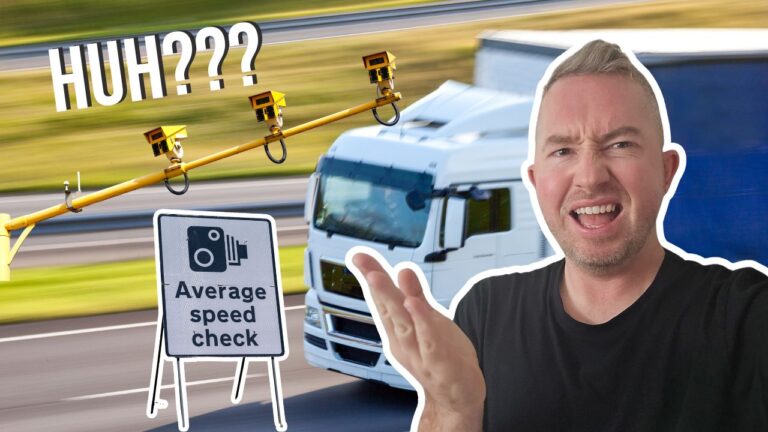If you’ve ever driven on UK motorways, you’ve likely experienced this: you’re carefully sticking to the average speed limit, yet a lorry seems to barrel past as if the limits don’t apply to them. This common perception often leaves drivers wondering about speed limits, lorry regulations, and whether there’s something they’re missing. So, why do lorries appear to move so quickly through average speed limit zones, and are they actually speeding?
1. Perception vs Reality
One key reason why lorries seem faster is down to perception. With their larger frames, high riding position, and rumbling engines, lorries create an illusion of greater speed. Smaller vehicles sticking to the speed limit can feel comparatively slow next to these road giants, even if both vehicles are travelling at similar speeds.
This perception is reinforced by the fact that lorries tend to maintain a steady pace over long distances, especially on motorways. While car drivers often fluctuate in speed, lorries are built and driven for consistency. This steadiness makes them appear faster, even if they’re technically keeping within the same speed limits.
2. Speed Limit Differences for Lorries Over 7.5 Tonnes
For larger lorries (those over 7.5 tonnes), UK law limits them to a maximum of 60 mph on dual carriageways and motorways. However, when average speed zones are in place, ranging from 50 to 60 mph, the difference between these lorries and smaller vehicles is less obvious. Lorries moving close to these limits may seem faster, but they’re usually just holding a consistent pace slightly shy of their typical cap.
3. Cruise Control, Speed Governors, and Speedometer Accuracy
Lorries are generally equipped with cruise control and speed governors, helping them adhere to a set speed with remarkable precision. It’s often said that speedometers in lorries are more accurate than those in most cars. While car speedometers can have slight variations, lorry speedometers are calibrated to reflect exact limits, ensuring compliance with stringent regulations.
This accuracy, combined with the lorry’s speed governors, means they can cruise at their maximum permissible speed without worrying about small discrepancies. For car drivers without such precise equipment, maintaining a consistent pace without creeping over can be a challenge. In an average speed zone, lorries might appear faster simply because they’re calibrated to hit that exact speed and hold it, without the minor fluctuations many cars experience.
4. Speed Camera Margins
There’s also the idea of a ‘margin of error’ given by speed cameras, often leading drivers to edge over the limit with a sense of relative safety. While speed cameras generally have a tolerance level (typically around 10% plus 2 mph), pushing this limit isn’t advisable. However, experienced lorry drivers familiar with the technology and regulations may occasionally edge right up to the maximum, knowing their vehicle’s calibrated limits more precisely. Even so, this isn’t a loophole anyone should rely on—speed cameras are constantly becoming more accurate, and many places enforce limits strictly.
5. Lorry Drivers’ Experience and Route Familiarity
Lorry drivers cover thousands of miles weekly, often on the same routes. This constant exposure means they’re incredibly familiar with average speed zones, speed cameras, and the ideal pace for each stretch of road. They know where the cameras are positioned and understand precisely how to manage their speed. Their experience and familiarity with the route give them the confidence to maintain a steady pace close to the limit, while car drivers unfamiliar with the route may slow down in caution or brake unnecessarily.
6. Aerodynamics and the Slipstream Effect
Lorries’ aerodynamic designs allow them to cut through air resistance with less fluctuation in speed than smaller vehicles. As a result, they maintain a steadier pace, even in windier conditions that might affect lighter vehicles. For those driving near a lorry, this effect—known as “drafting” or slipstreaming—may even make it feel as though the lorry is accelerating past, even if it’s keeping a constant speed.
7. Psychological Pressure
Driving around lorries can create a sense of psychological pressure. When a large lorry is behind or beside you, the sheer size and sound can feel intimidating. This can make drivers feel that the lorry is encroaching on their space, increasing the perception that the lorry is moving faster than it is. In reality, most lorry drivers are well aware of their road presence and are careful about giving others space.
Should We Be Concerned?
While it may seem concerning when large vehicles appear to zip through zones meant for safer, consistent speeds, in most cases, lorries are not speeding. Instead, they’re making use of advanced technology, familiarity, and training to maintain a consistent pace. The perception of speed often comes down to factors like road presence, psychological effects, and how we experience different vehicles on the road.
So, next time a lorry seems to surge past, take a moment to remember: it’s probably not breaking the limit but simply maximising technology and familiarity to keep to the letter of the law with confidence.

